“I would like to paint the way a bird sings.” ~ Claude Monet

Bonjour!
Today, a mini feast celebrating Claude Monet. There are very few of us who are not enamored with Impressionist art, and as writers, artists, and poets, we know only too well the great joy and frustration that can define the creative process.
You probably know that Monet developed cataracts late in life that severely impaired his acute perception of colors and light, the very hallmarks of his work. His world took on a yellowish tinge, and his paintings gradually became more reddish and muddied, the familiar scenes he so luminously depicted before appearing almost unrecognizable.
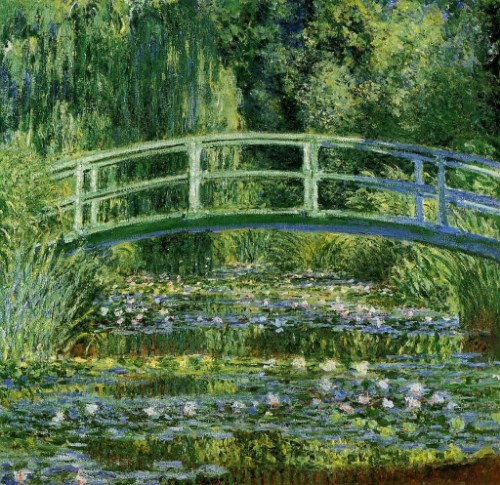
In a letter to a friend he said, ” . . . my poor eyesight makes me see everything in a complete fog. It’s all very beautiful just the same and it’s this which I’d loved to have been able to convey.” When he could no longer trust his eyes, he carefully read the labels on paint tubes, kept a regular order of colors on his palette, and painted from memory.

Lisel Mueller’s poignant “Monet Refuses the Operation” is a beautiful testament to the mind’s eye, an inspiring philosophy, an artist’s credo, a passionate affirmation for all creatives: there’s more than one way of seeing.

MONET REFUSES THE OPERATION
by Lisel Mueller
Doctor, you say there are no haloes
around the streetlights in Paris
and what I see is an aberration
caused by old age, an affliction.
I tell you it has taken me all my life
to arrive at the vision of gas lamps as angels,
to soften and blur and finally banish
the edges you regret I don’t see,
to learn that the line I called the horizon
does not exist and sky and water,
so long apart, are the same state of being.
Fifty-four years before I could see
Rouen cathedral is built
of parallel shafts of sun,
and now you want to restore
my youthful errors: fixed
notions of top and bottom,
the illusion of three-dimensional space,
wisteria separate
from the bridge it covers.
What can I say to convince you
the Houses of Parliament dissolve
night after night to become
the fluid dream of the Thames?
I will not return to a universe
of objects that don’t know each other,
as if islands were not the lost children
of one great continent. The world
is flux, and light becomes what it touches,
becomes water, lilies on water,
above and below water,
becomes lilac and mauve and yellow
and white and cerulean lamps,
small fists passing sunlight
so quickly to one another
that it would take long, streaming hair
inside my brush to catch it.
To paint the speed of light!
Our weighted shapes, these verticals,
burn to mix with air
and change our bones, skin, clothes
to gases. Doctor,
if only you could see
how heaven pulls earth into its arms
and how infinitely the heart expands
to claim this world, blue vapor without end.
~ Copyright © 1986 Lisel Mueller, from Second Language (Louisiana State University Press).
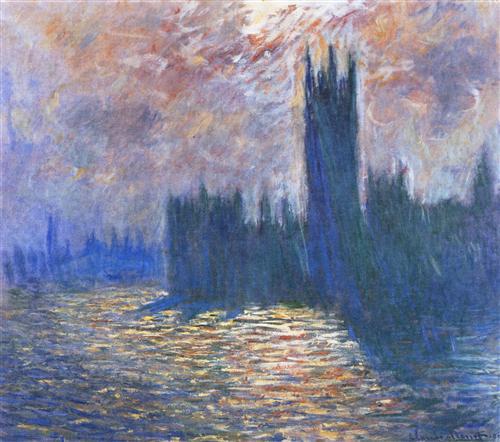
After years of resistance, Monet finally agreed to surgery on his right eye in 1923. With the lens in that eye removed, it is thought he then saw the world with UV vision, and his palette took on a bluish hue. Since he died just two years later and destroyed many of the paintings from his cataract period, we cannot fully assess what effect the surgery ultimately had on his artistic style.
* * *
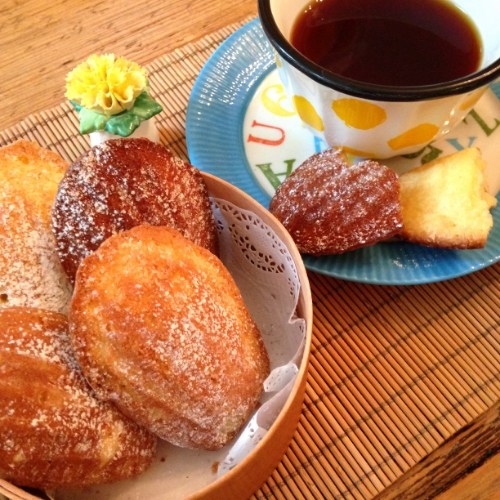
❤ CLAUDE MONET’S MADELEINES AU CITRON ❤
Did you know Monsieur Monet was as passionate about food as he was about painting? His gorgeous country home in Giverny was a place not only to paint en plein-air, but to host luminaries of the day for delicious 3-4 course meals largely prepared with ingredients from his own two-acre kitchen garden and farmyard.
Just as he planted his extensive flower gardens so he could paint them, he paid careful attention to the aesthetics of his kitchen and adjoining dining room, the blues and yellows so pleasing to the eye and therefore conducive to good appetite and fine conversation.


Monet kept cooking journals and was quite the gourmand, supervising daily meals which revolved around his work schedule. He rose early, had a hearty breakfast, then painted till lunch, served precisely at 11:30, so he could take best advantage of the afternoon light. Apparently he never invited guests for dinner, preferring to eat soup, leftovers, and cheese so he could retire early.
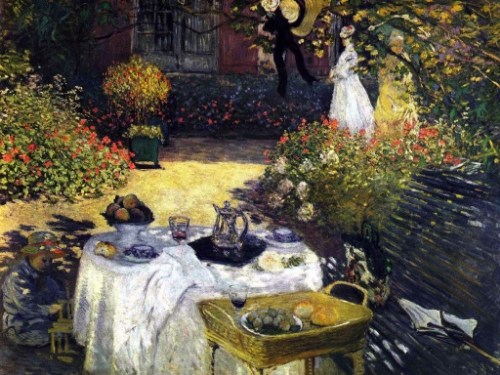
After a visit to Monet’s studio and greenhouses, guests such as Renoir, Pissarro, and Cézanne would enjoy lunch before relaxing with tea and sweets near the pond or under the lime trees. I can’t think of a better place to nibble on these scrumptious cake-like cookies, can you?

To make sure Monet’s favorite madeleines were prepared to perfection, we enlisted the services of Chef Bernaise, a recent graduate of the highly regarded culinary institute, Le Cordon Bear. I daresay he was a whiz in the kitchen, his light and airy madeleines a buttery dream with a refreshing hint of lemon.
One bite and we were instantly transported to a fragrant garden of climbing roses, anenomes, hollyhocks, daisies and poppies — and oh yes, near the pond, the weeping willows, wisterias, nympheas, and those glorious water lilies. 🙂

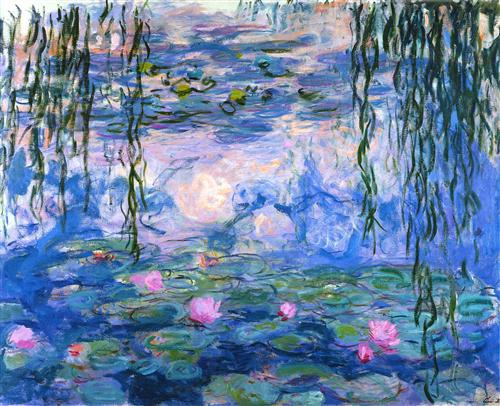
Chef Bernaise is confident that you, too, can recreate this mini symphony where palate meets palette. For now, enjoy another madeleine!

MADELEINES AU CITRON
- 1-1/4 cups sugar
- 1/2 cup unsalted butter, softened
- 4 eggs, separated
- 1 cup unbleached flour
- grated rind of one lemon
Preheat the oven to 400 degrees F.
Lightly grease and flour 12 madeleine moulds.
In a bowl, combine the sugar, butter and egg yolks, beating well until the mixture turns pale.
Beat the egg whites into soft peaks. Gradually add the butter mixture to the whites, alternately with one tablespoon of the flour mixed with the grated rind, until the mixture and the flour are used up.
Place a teaspoon of the mixture in each mould. Bake for 10 to 15 minutes.
~Adapted from The Modern Art Cookbook by Mary Ann Caws (Reaktion Books, 2013).
* * *
BAKING DAY AT GRANDMA’S GIVEAWAY WINNER!
Thanks for all your enthusiastic comments about Anika and Christopher Denise’s adorable new book! To pick the winner, the resident bears consulted with Monsieur Random Integer Generator, who only had to be bribed with 243 chocolate cakes.
We’re pleased to announce that the winner of a signed copy of Baking Day at Grandma’s, a wooden spoon, and some lovely gift tags is . . .
JOANNA MARPLE!
WooHoo! CONGRATULATIONS, JOANNA!!
Please send your snail mail address to: readermail (at) jamakimrattigan (dot) com so we can get your book out to you lickety split!
And thanks again, everyone, for entering!
* * *
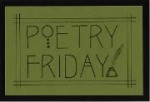 Ma belle Michelle is hosting the Roundup at Today’s Little Ditty. Take her some madeleines and check out the full menu of delicious poetic offerings being served up in the blogosphere this week. Bon Appétit!
Ma belle Michelle is hosting the Roundup at Today’s Little Ditty. Take her some madeleines and check out the full menu of delicious poetic offerings being served up in the blogosphere this week. Bon Appétit!
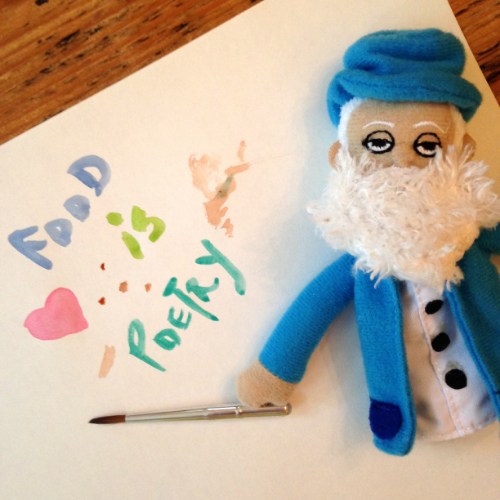
* * *
![]() This post is also being linked to Beth Fish Read’s Weekend Cooking, where all are invited to share their food-related posts. Put on your best bibs and aprons and come join the fun!
This post is also being linked to Beth Fish Read’s Weekend Cooking, where all are invited to share their food-related posts. Put on your best bibs and aprons and come join the fun!
————————————
** Thanks to Ruth at There’s no such thing as a God-forsaken town, where I first read “Monet Refuses the Operation,” and to Tabatha, for posting the link to the poem at The Opposite of Indifference.
Copyright © 2014 Jama Rattigan of Jama’s Alphabet Soup. All rights reserved.









“light becomes what it touches,” — lovely! Having lunch at Monet’s house must have been wonderful. I would love to visit his home someday. (I wonder why he destroyed his paintings? How sad.)
LikeLike
I dream about visiting Giverny too. LOVE his dining room and the special blue/yellow china he designed.
Apparently once his color perception was restored following the surgery he tried to repaint some of the older paintings and destroyed others. Fortunately his family was able to save a few paintings but many were lost.
LikeLike
Reblogged this on The Jackson Diner.
LikeLike
I remember once stealing the line “light becomes what it touches” to make a new poem. Thanks for the history lesson and recipe today. There are so many vitamins in your soup!
LikeLike
Yes, I LOVE that line too. It sums up Monet’s painting philosophy, doesn’t it?
LikeLike
This poem by Lisel Mueller is extraordinary. Thank you so much for sharing it here. These words simply shimmer:
Doctor,
if only you could see
how heaven pulls earth into its arms
and how infinitely the heart expands
to claim this world . . .
Love this!
All my best wishes to you, Jama. xo
LikeLike
Yes, I agree — you almost want to weep it’s so beautiful and extraordinary!
LikeLike
Ahh … merci beaucoup, Jama!
LikeLike
de rien, Annette! 🙂
LikeLike
Thank you for sweeping me away with the art, the poem, and the sweet fragrance of citron this morning, Jama! I was lucky enough to visit Giverny a couple years ago. How amazing it was to see the house, gardens, and chickens (though probably not the same ones) in person!
LikeLike
Sigh, you’re so lucky! I knew when I posted this someone out there has probably been to Giverny, and how wonderful that it turned out to be you, our PF host!
LikeLike
So great to hear this story, Jama. What an interesting crowd for lunch.
LikeLike
LOL, yes quite an interesting crowd. Imagine all those French words flying back and forth :)!
LikeLiked by 1 person
Thank you so much for sharing this story. I am inspired by all your blog posts. You cover all my favorite topics, food, art, books!
LikeLiked by 1 person
So glad to hear that. I sense another Monet post coming up in the not too distant future . . . 🙂
LikeLike
Love Lisa’s poem! *swoon*
LikeLike
Definitely swoon-worthy. Gets me every time — especially those last four lines.
LikeLike
Jama, I knew next to nothing about Monet and what a masterful job you have done, in so few words and beautiful images, of conveying the essence of his work and his soul. And the poem — oh, my! I wasn’t expecting to start my day with tears . . . thank you for this loveliness, my dear.
LikeLike
Thanks for the kind and generous words, Jessica. Lisel’s poem is so incredibly moving and poignant — she captured Monet’s great energy and passion for his work, but also his fear and frustration. I gather part of his reluctance to have the operation was because Mary Cassatt had been through it with less than positive results.
LikeLike
What a lovely post! Wish I’d had time to visiting Giverny on my one and only trip to France. This makes me long to go back. Thank you for brightening up my day!
LikeLike
I feel the same way — didn’t get to Giverny when I went to France long ago. Glad you enjoyed the post, Lori.
LikeLike
Oh my goodness, thank you, or should I say, merci? You don’t know how much I loved today’s post also! I spent thirteen years, 1999 to 2012, living in Nice, France, surrounded by amazing art galleries and impressionist exhibitions! I have seen several Monet originals.
LikeLike
Swoon — Monet originals! I’ve seen a few here and there. Always fascinating how blurry they look close up and then when you step back — wow!
Living in Nice sounds amazing — I’ve only stopped there briefly via a group tour. I do remember how dazzling the water looked. Also had a delicious scrambled eggs breakfast there. 🙂
LikeLike
So loved visiting Giverny, and this post takes me back there, Jama, to a happy and carefree time (backpacking through Europe for a while year!). Love that poem, too, especially these lines:
The world
is flux, and light becomes what it touches,
Thanks for the recipe, too – time to drag out my baking tin!
LikeLike
Another lucky Giverny visitor! You definitely need to make these madeleines :).
LikeLike
A visit to your blog lifts my spirit every single time. Thank you for sharing your knowledge of Monet and the lovely, lovely poem.
LikeLike
Aw, thanks so much, Margie — every time I visit your blog I become more and more impressed by your brilliant reviews. Seriously. Your insights into the books you feature are always interesting and enlightening.
LikeLike
Oh, lovely. Have you ever been to Rouen Cathedral? It is indeed made of “parallel shafts of sun.” It is glorious – he was right to refuse the operation.
And madeleines au citron are a perfect touch for this. Yum.
LikeLike
No, don’t think I’ve seen Rouen Cathedral — only Notre Dame. I didn’t realize Monet did around 30 paintings of the Rouen facade — amazing how many different lighting effects he was able to capture.
LikeLike
So wonderful to look at both of Monet’s footbridge paintings, and then to read Lisel Mueller’s poem. Love the perspective of this poem, especially:
What can I say to convince you
the Houses of Parliament dissolve
night after night to become
the fluid dream of the Thames?
I am trying to embrace the passage of time–this poem helps (as would Chef Bernaise’s madeleines…lucky you to have a cordon bear graduate in your kitchen.)
LikeLike
Yes, I love those lines too — made me miss London. I am not doing too well embracing the passage of time — but I agree madeleines and good poems do help!
LikeLike
oh, I want his kitchen and his gardens and and and…thank you Jama, for posting this beautiful piece and for the poem which has always been one of my favorites…
LikeLike
I imagine every time you dined with Monet in that beautiful yellow room you were part of a new still life. . .
LikeLike
Chef Bearnaise needs his own book!
LikeLike
Mais oui!
LikeLiked by 1 person
gorgeous post, Jama. Thank you!
LikeLike
Thanks for reading, Kelly!
LikeLike
“Food is Poetry” – I couldn’t agree more, Jama. I love how Lisel Mueller’s poem captured the “benefits” of failing eyesight. I recently got my first pair of Rx glasses…sometimes the fuzzy images are easier to see, especially on my face. LOL = )
LikeLike
I’ve worn prescription glasses since second grade. Now I wear contacts + OTC reading glasses sometimes and things are still blurry!
LikeLike
Jama, you are amazing! Each one of your posts is a work of art, an ode to poetry! Love the poem. Some years ago I was fortunate to visit Rouen and Monet’s Garden. I took lots of photos, some of which I used in this brief video for a classical music/poetry CD called THE SONG WE CHOSE TO SING: http://www.youtube.com/watch?v=31HmK-UMwMY . The next day we were in Paris, went to L’Orangerie Museum, and saw Monet’s floor-to-ceiling water lily paintings–fantastic. I’ve always enjoyed the lovely Swedish book LINNEA IN MONET’S GARDEN. Thanks for bringing back these fond memories!
LikeLike
Thanks for sharing the video link, Joan – what a beautiful poem and loved the photos! Lucky you seeing those floor-to-ceiling paintings!! I’m also a fan of Linnea in Monet’s Garden; I think I have three of Lena Anderson’s books. 🙂
LikeLike
I hope Chef Bernaise can visit Giverny one day. Such a wonderful place. In the meantime, please pass the madeleines au citron!
LikeLike
You’ve been there too? Wow, such a well traveled group we have here. Chef Bernaise tells me he’d like to cook at Giverny someday, a luncheon for notable ursine luminaries such as Shakesbear, Bearthoven, Amelia Bearhardt, and Lauren Bearcall. Any furry residents of Gourmandistan would be welcome too. 🙂
LikeLike
Ah, if those cookies transport you to that garden, I must make them. More appealing than traveling through 7 volumes of memories with Proust. I think of long loving that poem, but when I came to the end of your post where you credit Ruth with introducing and Tabatha for linking, I was so impressed with your memory. I must have met this poem in those places, then went to buy her selected works, and forgotten that introduction; your reminder of the sources made me happy to follow that trail back. Such great Poetry Friday-ers! All deserve extra helpings of madrilenes, with extra extra for you for this feast.
LikeLike
I’ve been introduced to several wonderful poets via PF and now need to get my own collection of Mueller’s poems. I had actually googled “Monet poem” and read it at the Poetry Foundation, blown away, but thinking I had read it somewhere else before. Then I saw Ruth’s blog in the Google results and reread our comments. No matter how many times I read this poem, it gets me every time. Talk about actually finding words for the ineffable! Enjoy your madeleines!
LikeLike
It was nice to bring back memories of Giverny, his kitchen is so awesome, especially the oven.
LikeLike
It’s the kind of kitchen that makes you really want to cook! Envy your having been there.
LikeLike
Monet and poetry and a recipe! I have a Monet and Giverny cookbook — I bet those madeleines are in there. Thanks so much for the info about Monet’s eyes and how his issues affected his paintings. Fascinating.
LikeLike
Is the book you have called Monet’s Table? I just received my copy yesterday, and yes the madeleines recipe is in there. 🙂
LikeLike
I LOVE this post! So much information about Monet, things I didn’t know and found v interesting. That kitchen was, is, gorgeous.
Nice work on the Madelines. They can be difficult and I have sure burned my share. You did a lovely job here.
LikeLike
Madeleines are easy to over-bake — I could have taken my first batch out sooner. The non-stick pan I have baked up quicker than my regular pan — that’s why some of my madeleines turned out browner than others.
LikeLike
Jama — I met a friend for lattes and treats this week and we had lemon madeleines! Great minds think alike, lady. Your confections look delicious.
LikeLike
Great minds, indeed!
LikeLike
Every time I visit, I’m amazed by your exquisite connections between poetry and cooking. Food for the soul and food for the body. And today you brought in one of my favorite artists. I didn’t know any of this about Monet. And I love Lisel’s poem- I’ve been thinking a lot lately about how differently I see the world now than I did 25 years ago. This is one for saving and sharing. Thank you!
LikeLike
Thanks for your nice comment, Carol. Happy to hear you also love Monet’s work. I found it fascinating that he suffered from cataracts for so many years yet pressed on, determined to keep painting what he was able to see. It’s easy to understand his apprehension about eye surgery, not unlike a singer not wanting to have surgery on his/her larynx. You just never know.
LikeLike
Love the info about Monet, love the poem and photos…Love this post!!
LikeLike
Thanks, Vicki!
LikeLike
Giverny was lovely – I was lucky enough to be in a small group let in before normal opening so we had real tranquillity there. Cheers from Carole’s Chatter!
LikeLike
How wonderful, Carole!
LikeLike
I visited Monet’s house and gardens in France years ago and loved seeing what I’d seen in his paintings in real life!
LikeLike
How exciting!
LikeLike
A feast for both eyes and mouth! YUM!!
LikeLike
Have another madeleine, Mary Lee :).
LikeLike
Lovely post! I’ve been doing some reading on the Impressionists lately, so that improves my enjoyment even more!
LikeLike
Thanks to you for first posting this poem at your blog, Ruth. I’m currently reading Monet’s Table so I can learn more about the family’s culinary adventures.
LikeLike
Wow! What a marvelous post, Jama. I’m a big Monet fan, but knew little about him before this. Love the poem and all the beautiful images too. But now you’ve made hungry as well!
LikeLike
Thanks for visiting, Carmela. Hope you try the recipe sometime :).
LikeLike
What a wonderful post. While I’m familiar with Monet’s painting I knew absolutely nothing about him as a person. The cataracts surgery and the effects it had on his art are really intriguing and make me want to find a biography of him. The Madelienes look delicious. Great post!
LikeLike
Thanks, Katherine. I’m intrigued to learn more about him too — and to try more recipes from Monet’s Table. 🙂
LikeLike
That sounds awesome! You can see the difference in his eyes through his paintings! 😀
LikeLike
He only had the surgery on one eye, so for the rest of his life he was never able to “see” the world in the same exquisite way as when he did his finest paintings.
LikeLike